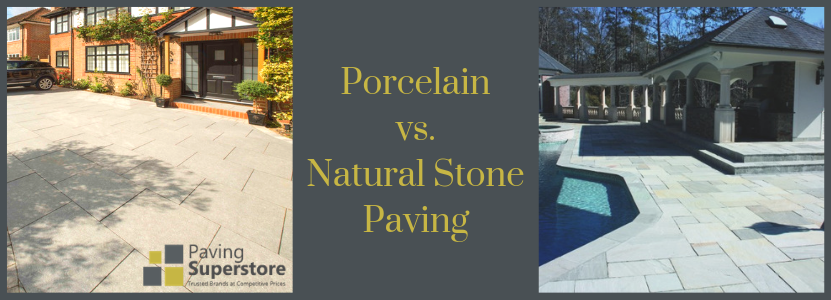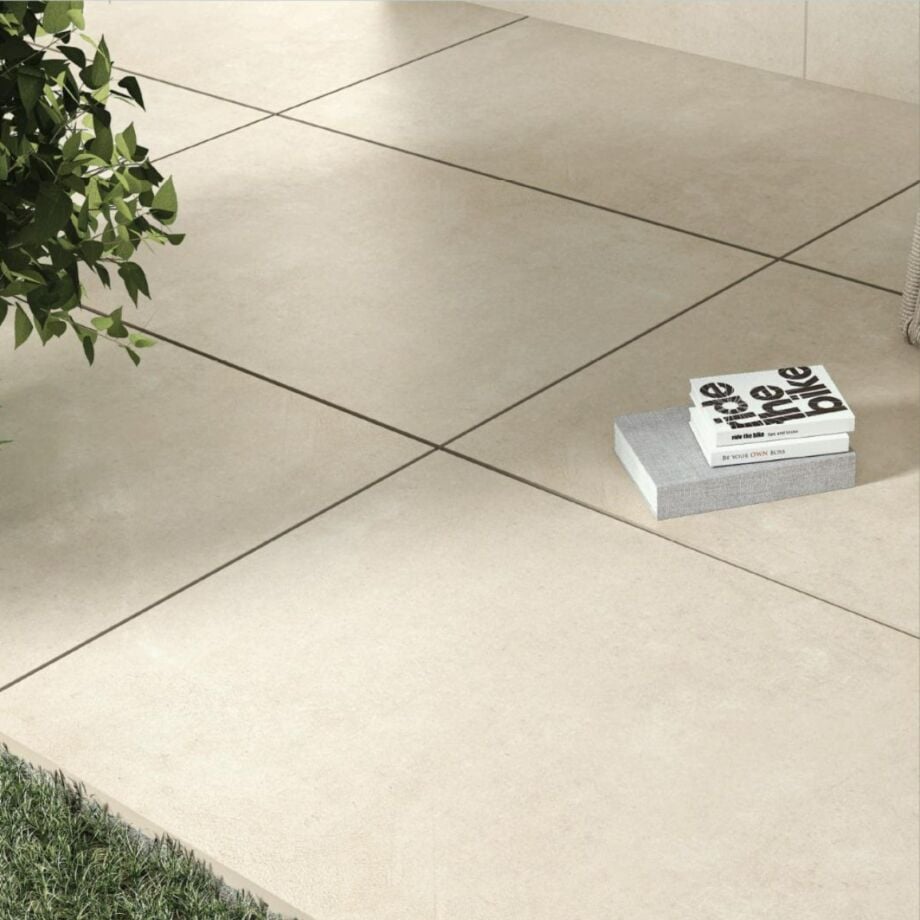
Porcelain paving is a popular choice for outdoor areas, such as patios and pool decks. But there's a lot of confusion about what it is and what it isn't. Is it slippery when wet? Can you install it yourself? Should you seal it? This blog post seeks to answer all your questions about porcelain paving so you can make an informed decision about whether it's the right choice for your outdoor project. From understanding the manufacturing process and installation guidelines, to tips on how to clean and maintain your paving, read on to learn all there is to know about porcelain paving slabs.
What is Porcelain Paving?
Porcelain paving, also known as vitrified paving is a type of flooring made to the high standards necessary for outdoor use. Porcelain tiles are made from a type of clay called kaolin (a white soft clay) along with feldspar and siliceous sands. The colour and pattern are imprinted upon the surface of the stone and seeps into the top layer, similar to a inkjet printer. The materials are then fired at high temperatures in excess of 1200°C which closes the pores and creates a hard, strong tile. Porcelain paving was traditionally made in Italy, known for its high quality materials and manufacturing standards, however more recently other markets have emerged such as Turkey and India.
Porcelain paving is available in a variety of colours and styles, and can be used for both indoor and outdoor applications.
Porcelain paving is slip-resistant and durable, making it an ideal choice for high-traffic areas. It is also easy to clean and maintain, and is resistant to staining and fading. Porcelain paving is a popular choice for patios, pool decks, walkways, and driveways.
What are the Benefits of Porcelain Paving?Porcelain is an excellent choice for paving because it is strong and durable. It is also easy to clean and maintain. Porcelain is less likely to stain than other materials, and it resists fading from sunlight exposure. Key Advantages:1. Durability – Porcelain is extremely durable and can withstand heavy foot traffic and weather conditions. Its low water absorption means it is less prone to stains and algae than other paving materials. It is highly resistant to UV, frost, salt and acid. 6. Coordinating Wall Cladding - There are many wall cladding options made from porcelain to complement the paving ranges. These are ideal for covering and existing wall or for creating a unique and stylish area within your home or garden. 7. Indoor / Outdoor - Continue the look indoors by using the same porcelain paving both outdoors and indoors. 8. Driveway - Many porcelain are made to a thicker standard to enable them to be used on a driveway. These are a minimum of 30mm thick or solid porcelain or some ranges are manufactured using a 10mm porcelain veneer attached to a concrete backing at a thickness usually in excess of 50mm enabling them top be laid on sand iof preferred. Key Disadvantages:1. Cutting - Porcelain paving requires the use of a specific porcelain blade for cutting the stone. It must be cut slowly and using water as the material will crack if it becomes too hot when cutting. An experienced contractor will have no problems cutting porcelain paving. 2. Marking - Porcelain paving will temporarily mark if leaves for example are left on the surface and not cleaned away. There are tannins within leaves that will mark the stone although this can be cleaned off and will also fade through normal weathering. 3. Slurry Primer - When laying porcelain paving, it's essential to use a slurry primer on the reverse side of the paving slabs to aid adhesion. Due to the low porosity of the stone, the tiles will not stick down without a slurry primer. |
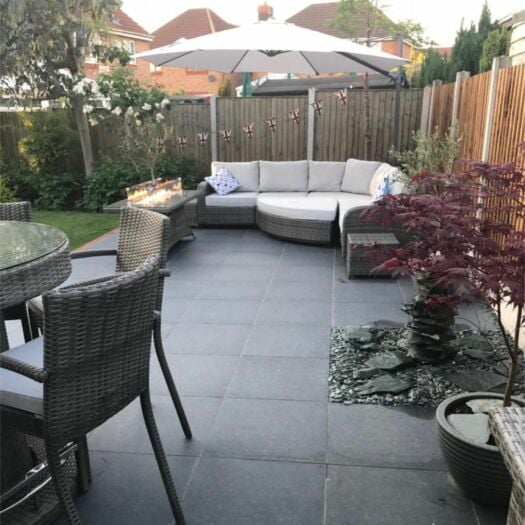 |
Is Porcelain Paving Slippery?
When it comes to porcelain paving, one of the most common questions we get asked is whether or not it’s slippery. The short answer is no, porcelain paving is not slippery. In fact, it has a very low slip coefficient and is actually more slip-resistant than many other types of paving materials.
So why is porcelain so slip-resistant? It’s all thanks to its textured surface. The tiny pores on the surface of each paver act as miniature suction cups, providing a firm grip even when wet.
Of course, no paving material is completely slip-proof, but the grading of exterior porcelain is usually classified as R11 which means it is ideal for outdoor use. The R rating is performed using a ramp test. The ramp test (R rating) is often used for porcelain paving and this is conducted using a ramp which is gradually raised. Oil is applied to the ramp and a test person walks onto the ramp wearing boots. The measurement is taken from the point at which they slip. R11 is the rating usually applied to porcelain paving and this is equivalent to the value of 34 to 51 in the PTV test data (pendulum test value).
The following table shows the slip test data ratings for both test types and the recommended usage for paving conforming to each result.
| R Rating | Suitable for |
|---|---|
| R9 | Only for use indoors in areas where the floor is never wet |
| R10 | Typically for use indoors including areas that occasionally become wet, such as kitchens |
| R11 | Ideal for outdoor use including around swimming pools, internally in bathrooms, wet rooms |
| R12 | Ideal for outdoor use including around swimming pools, internally in bathrooms, wet rooms |
Do not confuse porcelain paving with glazed ceramic tiles as these are a completely different material that is rarely suitable for outdoor use.
Full Bodied or Colour Bodied - What does this Mean?
When porcelain paving is manufactured, it is produced to different colour standards. These are described as either Full Bodied or Colour Bodied. What does this mean?
Full Bodied - This is the premium standard in porcelain paving manufacture and means that the body of the paving slab is carefully colour matched to the surface of the tile. If minor accidental damage occurs during installation or during everyday wear and tear, the small chip or damage is less likely to draw attention. Full Bodied paving is also most suitable if the installation requires an edge of the paving to be exposed, for example when using as steps or coping as the exposed edge will resemble the same colour as the surface of the material.
Colour Bodied - This porcelain is constructed with a similar matching colour body to the surface, but not such a close match as the Full Bodied material. In the majority of cases, this will not be of significant importance, however in applications where an exposed edge is needed such as bullnose steps or coping, it may be preferable to consider a Full Bodied option.
Porcelain Dimensional Accuracy
As with colour types, porcelain paving is also produced to different dimensional standards described as Rectified and Non-Rectified. These allow for more or less precision when positioning tile joints when laying the paving. These are described below:
Rectified Paving - This paving is cut to size subsequent to firing in the kiln meaning that it has minimal dimensional tolerances between individual slabs of up to 2mm +/- on the nominal size within each batch. Each batch of stone may vary by up to 5mm from another batch and the tolerances between slabs within the same batch will be up to 2mm difference. When laying rectified paving, recommended joint widths should be between 3mm to 15mm. If purchasing additional paving at a later stage, always purchase the same batch number where possible.
Non-Rectified - This paving is cut to size prior to firing in the kiln and therefore sizes may differ between individual slabs within the same batch as the paving expands or contracts whilst firing. It is possible for individual slabs to vary by up to 5mm +/- withi the same batch. Paving is sorted into batches with the closest sizes grouped together. These batches are also known as work sizes and although the paving may be shown as measing 600x600mm, one particular work size may measure an average of 594x594mm. For non-rectified paving, it is recommended to use jint widths raning from 5 to 15mm. If purchasing additional paving at a later stage, always purchase the same batch number where possible.
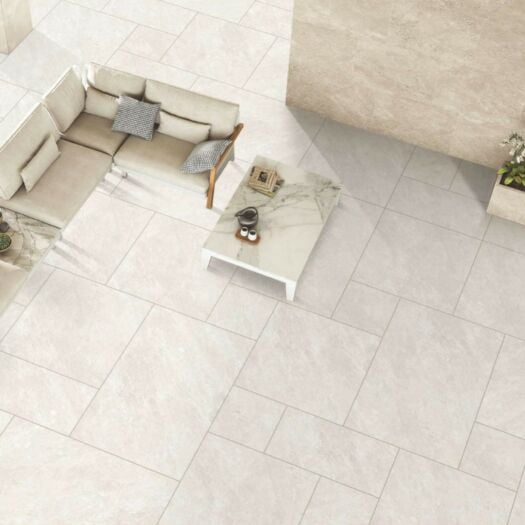 |
Installation of Porcelain PavingPorcelain paving is a popular choice for both indoor and outdoor spaces. It is durable, easy to clean, and has a variety of colours and styles to choose from. While porcelain paving is generally very easy to install, there are a few things to keep in mind in order to ensure a successful installation. Excavate the area and then use a compacted MOT Type 1 sub-base layer at 100mm thick. Can I Install Porcelain Paving on Raised Pedestals?Yes! Exterior porcelain paving is usually 20mm thick and this is suitable for laying on pedestal risers. For larger slabs, you will need to use intermediate pedestals along the length of the slab in addition to using on the corners. |
Should I Seal Porcelain Paving?
The simple answer is no. Due to porcelain paving's low water absorption, the paving will not absorb an impregnator sealer into the stone and this will instead just stay on the surface and possibly mark the stone. Alternative topical sealers are can occasionally wear away unevenly and leave unsightly patches. As porcelain paving is known for its high stain and algae resistance due to its low porosity, just removing surface debris and leaves is usually sufficient to keep the paving clean.
Porcelain Accessories
Many patio projects require additional accessories such as bullnose step treads and wall coping. It's possible for these to be made to order for you on many of our ranges - please contact us for details.
Porcelain Batches
As porcelain is produced in batches, always keep a note of your batch numbers as if you require more at a later stage, it is recommended you request the same batch where possible. Over time, the older batches will become unavailable so when planning your project, always ensure you buy enough for your needs. It is recommened that you buy 10-15% more than is needed to allow for accidental damage, cuts or changes to your plans.
How to Clean PorcelainTo keep your porcelain paving in tip top condition, it's neecessary to undertake some basic maintenance task from time to time. Here are some tips: -Sweep the surface of your porcelain paving to remove any fallen leaves or debris as these may temporarily mark your paving. |
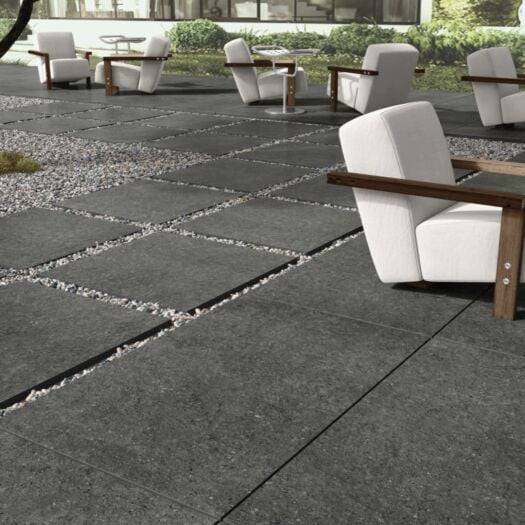 |
 Conclusion
Conclusion
In conclusion, porcelain paving is an excellent option for both indoor and outdoor applications. It is a durable, low maintenance material that can offer a unique look to your home and garden. Furthermore, it's non-slip surface offers greater security when outdoors in wet conditions. With all these features combined, it's easy to see why porcelain paving is becoming increasingly popular and will continue to be for years to come.


